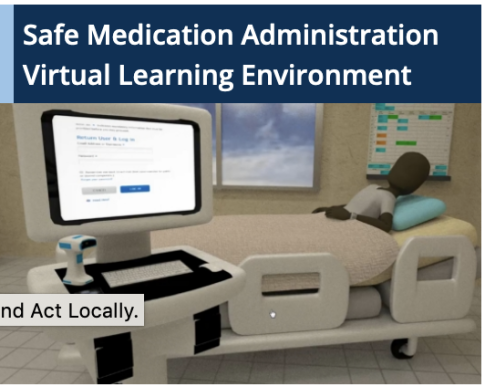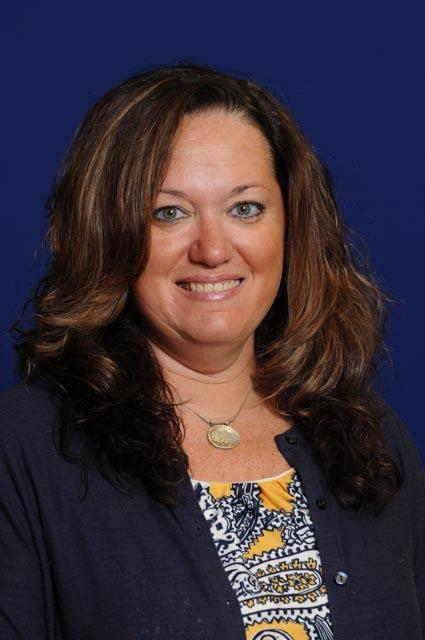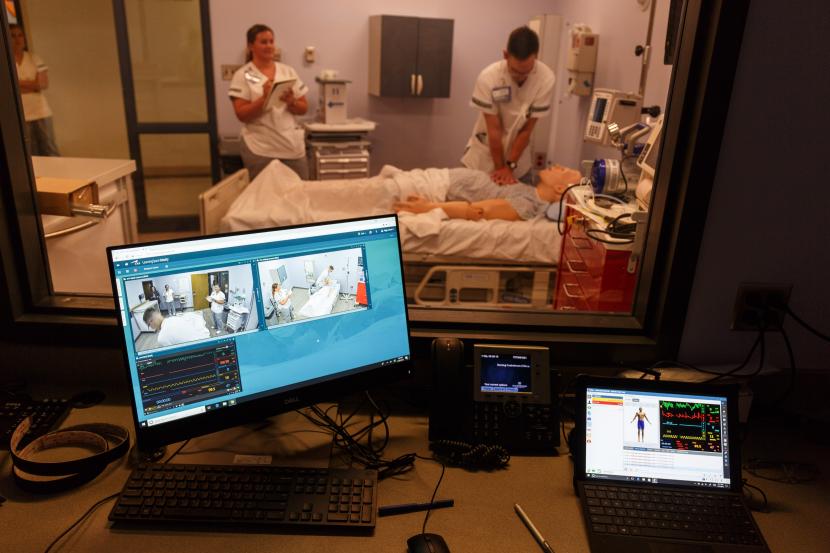"We were also using this before COVID-19 to prepare for clinicals, but it's even more useful now," said Beth Tremblay, a lecturer at the School of Nursing.
By Irvin B. Harrell
One of the educational hurdles during the COVID-19 crisis has been its impact on clinicals for certain health-care programs. For instance, nursing programs across the country had to discontinue experiential learning exercises.
Seeing that nurse educators needed resources for their classes and desired learning outcomes online, Old Dominion University's School of Nursing teamed with ODU's Center for Learning and Teaching to develop a virtual learning environment. The Medication Administration Safety Simulation program allows students to use gaming to practice the steps of safe medication administration.
In April, the program was converted to a format that could be shared with other nurse educators across the country during the pandemic. It was posted on two nurse educator resource listserves.
"In less than a week, more than 380 nurse faculty from across the country, as well as Liberia and South Africa, downloaded the software program," said Janice Hawkins, a clinical associate professor at the School of Nursing who worked on the program.
Among the universities downloading the program were University of Michigan, University of Arizona, Auburn University, Florida A&M University and Loyola University Chicago.
The reach of the program has continued to grow. To date, there have been 547 downloads from educators in 14 countries who indicated that they planned use the program with approximately 48,000 students, Hawkins said.
Initial feedback from 885 student users has been extremely positive:
- 93.64% say they are more confident with the steps of performing safe medication administration after completing the virtual simulation.
- 93.82% say they are more knowledgeable of the steps of performing safe medication administration.
- 93.75% felt the information from the virtual learning exercise will be beneficial to them in their professional roles.
Joining Hawkins in the development of this simulation program were David Figgs, the school's nursing simulation technician; Dan Greenwood, an instructional technology specialist manager; Deborah Norris, an instructional designer; Brian Williamson, a multimedia designer; and School of Nursing instructors Beth Thompson, Beth Tremblay and Lynn Wiles.
Hawkins provided an analogy of how the simulation works.
"For basic life support, students used to come to class and learn CPR and then take the skills test. Now they learn and practice online and then take a face-to-face skills test, which reduces the time needed in class," she said. "This kind of works like that. This could be used in place of classroom/lab instruction that normally prepares students for clinicals."
Wiles, director of technology and simulation at the School of Nursing, cautions that while the simulation provides an avenue to continue instruction of clinical skills while teaching remotely, it won't take the place of in-person clinicals.
"But this does help keep students engaged and allows us to prep for clinical when we can't get to our labs," she said.
"We were also using this before COVID-19 to prepare for clinicals, but it's even more useful now," added Tremblay, a lecturer at the school.
The project was truly a product of collaboration and complexity. Figuring out how to orchestrate the simulation in a virtual world posed challenges for designers Williamson and Greenwood. Williamson worked on the 3D animations and graphical elements for the project. Greenwood handled all the interactivity and produced the animations and graphics using an open source 3D animation program called Blender.
"The nursing faculty did a run-through using ODU's simulation patient rooms. They recorded video using their phones," Williamson said. "This was invaluable for me to see the procedures step by step. I used that video walkthrough to plan the animation."
The attention the initiative has garnered thus far has been through word of mouth, listserves and on nurse educator forums. The resource will be highlighted in upcoming editions of Reflections on Nursing Leadership and the American Journal of Nursing.
"We're definitely expecting wider usage once that comes out," said Hawkins, who added that the simulation, from inception to implementation has been a path paved in "wins."
"There's a need, it's free, it's a fun demo to share and it was a product of intraprofessional collaboration," she said.
Related News Stories
Virtual ODU Summer Arts Series Announces Events for July and August
First up is a calligraphy presentation by ODU’s Christen Turney on July 16. (More)
ODU Education Students Create Virtual Lesson Plans On The Fly
Professor Jody Sommerfeldt’s class helped a Chesapeake school switch to remote learning. (More)
ODU’s Online Program Is Ideally Suited to Facilitate Education in All Circumstances
The University, a longtime leader in distance learning, offers more than 110 degrees that can be partially or wholly completed online. (More)







